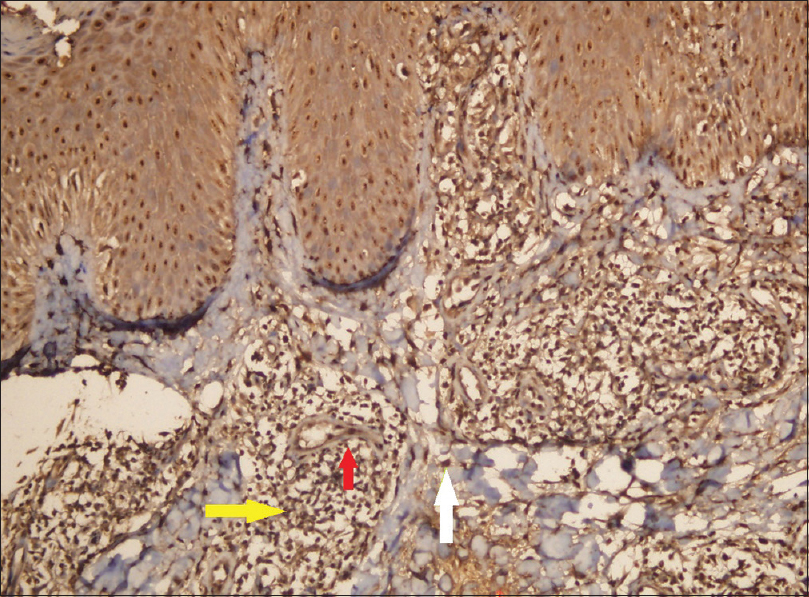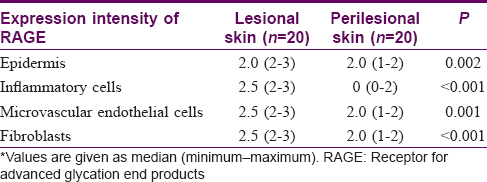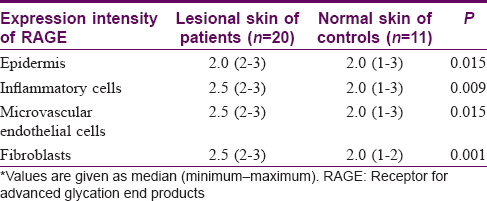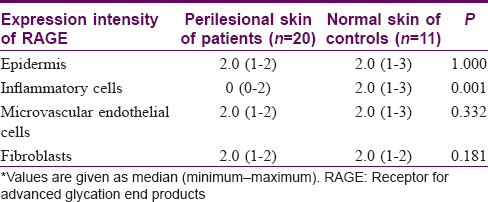Translate this page into:
Receptor for advanced glycation end products is overexpressed in psoriatic plaques independent of disease severity
2 Department of Dermatovenereology, Ankara Ataturk Training and Research Hospital, Kastamonu, Turkey
3 Department of Pathology, Ankara Ataturk Training and Research Hospital, Kastamonu, Turkey
4 Department of Biostatistics, Kastamonu University School of Medicine, Kastamonu, Turkey
Correspondence Address:
Gulsen Akoglu
Department of Dermatovenereology, Ankara Ataturk Training and Research Hospital, Bilkent, Ankara
Turkey
| How to cite this article: Ozgor O, Akoglu G, Sungu N, Karaismailoglu E, Aktas A. Receptor for advanced glycation end products is overexpressed in psoriatic plaques independent of disease severity. Indian J Dermatol Venereol Leprol 2017;83:556-560 |
Abstract
Background: Enhanced expression and excitation of the receptor for advanced glycation end products is considered to play a role in the regulation of many pro-inflammatory genes involved in the pathogenesis of psoriasis.Aim: We investigated the expression of receptor for advanced glycation end product in various cell types, in lesional and peri-lesional skin of patients with psoriasis, and its correlation with disease severity.
Methods: Paraffin-embedded punch biopsy tissue taken from psoriatic plaques and peri-lesional normal appearing skin tissue of twenty patients with psoriasis, and normal skin samples of eleven healthy participants, were enrolled in the study. The sections were stained immunohistochemically with anti-receptor for advanced glycation end product antibody. The intensity of receptor for advanced glycation end product expression was assessed semi-quantitatively on epidermal cells, microvascular endothelium, dermal fibroblasts and inflammatory cells. They were graded as follows: 0 (no staining), 1 (weak), 2 (moderate) and 3 (strong) intensity.
Results: Receptor for advanced glycation end product expression on epidermis, microvascular endothelium, inflammatory cells and fibroblasts in the psoriatic plaques was more intense than perilesional and normal tissue (all P < 0.05). It did not correlate with disease severity.
Limitations: The main limitation of our study is that this was a semi-quantitative assessment, detected immunohistochemically in skin biopsies.
Conclusion: Receptor for advanced glycation end product expression may have an important role in psoriasis pathogenesis, independent of disease severity.
Introduction
Psoriasis is a multifactorial, chronic inflammatory skin disease, associated with complex interactions of various types of cells in the epidermis and dermis. The exact etiopathogenesis of psoriasis is still not clear.
The receptor for advanced glycation end products is a multiligand receptor. It has many ligands such as advanced glycation end products, high-mobility group box protein 1, S100/calgranulin, beta amyloid, phosphatidylserine, C3a and advanced oxidation protein products.[1] These are produced by various inflammatory cells. After ligand-receptor interaction, signal transduction affects many important pro-inflammatory pathways, resulting in a chronic inflammatory state.[2] The interaction of receptor for advanced glycation end product and its ligands activates many kinases, such as extracellular signal-regulated kinases 1 and 2, phosphatidylinositol-3 kinase, mitogen-activated protein kinases, stress-activated protein kinase/c-Jun N-terminal kinase and Janus kinases.[3] Subsequently, various transcription factors, especially NF-κB, are activated to promote the inflammation processes. Receptor for advanced glycation end product expression is constitutively expressed in different cell types, and its ligands and inflammatory mediators induce its overexpression. Pro-inflammatory consequences of this activation are hyperproliferation, immune system activation, lymphocyte infiltration into the epidermis and cytokine induction, all of which are observed in psoriasis pathogenesis.[4] We were unable to find any previous reports about the expression profile of receptor for advanced glycation end product in different types of cells in psoriatic plaques compared with normal skin in healthy participants.
The present study aimed (i) to evaluate the presence of receptor for advanced glycation end product expression on epidermal, endothelial, inflammatory cells and fibroblasts in lesional and peri-lesional skin of patients with psoriasis, (ii) to compare the intensity of its expression between patients with psoriasis and healthy participants and (iii) to investigate the relation between the intensity of its expression and disease severity.
Methods
Subjects
Twenty patients who were clinically and histopathologically diagnosed as having chronic plaque psoriasis in the dermatology outpatient clinic of Ankara Ataturk Training and Research Hospital, were enrolled in this prospective study. Patients included were not on topical therapy for at least two weeks, and not on systemic or phototherapy for the last six months. The demographic and clinical data of the patients including age, gender, age of onset, disease duration, psoriasis area and severity index scores, and previous treatments were noted. The control group constituted of eight healthy women who underwent mammoplasty and three men. The controls were matched with patients according to age and gender. None of the patients or controls were younger than eighteen, obese, or had a history of smoking. The controls did not have any systemic illness, were not on any medication, and had no history of alcohol intake. The women were not pregnant or lactating.
Four millimeter punch biopsies from psoriatic plaques and peri-lesional skin (2 cm away from psoriatic plaques) were obtained from sun-protected regions. The biopsy specimens of the control group were taken from sun-protected body regions. The study was approved by the hospital ethics committee, and all participants signed the informed consent form.
Evaluation of immunoreactivity
The epidermis, inflammatory cells (lymphocytes), microvascular endothelial cells and fibroblasts were examined for receptor for advanced glycation end product expression. To evaluate this, semi-quantitative analysis with a scale ranging from no staining (0), weak (1), moderate (2) to strong (3) intensity was performed in the biopsy specimen as described in detail in this reference.[5] Dermal fibroblasts were identified as spindle cells with a clear separation from vessels.[6]
Statistical analysis
Evaluation of normality was performed with the Shapiro–Wilk test. Normally distributed continuous variables were expressed as mean and standard deviation (mean ± standard deviation), and were compared with Student's t-test for independent groups. Abnormally distributed continuous variables were expressed as median, and were compared with Mann–Whitney U-test for independent groups. Categorical data was reported as numbers and percentages, and compared with Pearson's Chi-square test or Fisher's exact test. Wilcoxon test was performed for comparing receptor for advanced glycation end product expression intensity of lesional and peri-lesional skin samples. Spearman correlation test was used to analyze correlation between receptor for advanced glycation end product intensity and clinical features of patients. P < 0.05 was considered statistically significant. All statistical analyses were performed using SPSS version 15.0 statistical software package (SPSS Inc., Chicago, IL, USA).
Results
The study included twenty patients with psoriasis (ten women and ten men) and eleven healthy controls matched for gender and age (eight women and three men). [Table - 1] presents the demographic characteristics of the study population. [Figure - 1], [Figure - 2], [Figure - 3] show staining scores for receptor for advanced glycation end product in lesional and peri-lesional skin samples of patients with psoriasis, and comparison with controls.
 |
| Figure 1: Control, score: 0 (RAGE, ×400) |
 |
| Figure 2: Weak staining for receptor for advanced glycation end product (score: 1) on microvascular endothelium (red arrow) and inflammatory cells (yellow arrow) in the perilesional skin (RAGE, ×200) |
 |
| Figure 3: Strong staining for receptor for advanced glycation end product (score: 3) on microvascular endothelium (red arrow), inflammatory cells (yellow arrow) and fibroblasts (white arrow) in the lesional skin of the same patient (RAGE, ×200) |

As shown in [Table - 2], the intensity of receptor for advanced glycation end product expression in the epidermis, microvascular endothelial cells, inflammatory cells and fibroblasts in psoriatic plaques of patients was significantly higher than their peri-lesional counterparts (all P < 0.05). The intensity of expression in all these cell types was stronger in lesional samples than those of healthy controls (all P < 0.05) [Table - 3]. The peri-lesional skin of patients did not have different expression levels in the epidermis, microvascular endothelial cells and fibroblasts (all P > 0.05), except for inflammatory cells, when compared with controls [Table - 4]. The intensity of receptor for advanced glycation end product expression in the inflammatory cells of peri-lesional skin of patients was weaker than healthy controls (P = 0.001).



Statistical analysis did not show any correlation between the intensity of expression in lesional and peri-lesional tissue with respect to the patients' age, gender, disease duration, age of onset or disease severity (all P > 0.05).
Discussion
The skin and lung are unique regions, in which the receptor for advanced glycation end product expression is high throughout life.[7],[8] Pathologically upregulated expression is demonstrated in diabetics, patients with chronic inflammatory disorders including Alzheimer's disease, atherosclerosis, malignancies and in ageing.[5],[8] Furthermore, it was found to be overexpressed in psoriatic epidermis,[9] sun-exposed skin,[5] on the reticular dermis, extracellular matrix of patients with localized systemic sclerosis and calcinosis, which suggested its possible contribution in inflammatory skin disorders.[6] This is the first study that demonstrates the overexpression of receptor for advanced glycation end product in various cell types that are involved in psoriasis pathogenesis. Epidermal, microvascular endothelial, inflammatory cells and fibroblasts showed more intense expression in psoriatic plaques than the normal-appearing skin of patients and healthy controls. It is shown to work as an adhesion molecule for leukocytes as it interacts with leukocyte beta-2 integrin Mac-1.[10] Psoriasin (S100A7) induces oxidative stress in both endothelial and epithelial cells, acting through receptor for advanced glycation end products.[11] Ligand-receptor for advanced glycation end product interactions induce several signal pathways, including NF-kB, which is suggested to be involved in the pathogenesis of psoriasis. Activation of NF-kB results in the release of pro-inflammatory cytokines, cell adhesion molecules, metalloproteinases and regulates immune system cells.[1],[4],[8] Activated NF-kB binds to the promoter region of receptor for advanced glycation end product in the nucleus, and enhances its expression as well as inhibits glyoxalase 1 expression. This results in the upregulation of advanced glycation end product formation.[12] NF-kB activation is considered to be an important link between the innate and adaptive immune system.[13] The consequence of this process leads to the sustained activation of NF-kB.[14] The major impact of receptor for advanced glycation end product signaling is considered to be the conversion of a transient cellular stimulation into a sustained cellular dysfunction, and a prolonged inflammatory response.[15] Our findings point to the possible essential role of receptor for advanced glycation end product activation, affecting many cell types in psoriasis.
Experimental studies about the role of receptor for advanced glycation end product and its ligands in psoriasis pathogenesis are limited in number. Wolf et al. reported a mouse model, in which they showed that elevated levels of mS100a7a15, a receptor for advanced glycation end product ligand, was associated with Koebner phenomenon. The tissue had increased levels of Th1 and Th17 cytokines, and demonstrated all major histopathological features of psoriasis, including epidermal T-cell infiltration, Kogoj spongiform pustule, Munro's abscess formation, hyperkeratosis and dilated dermal vessels. The researchers suggested S100A7A15-receptor for advanced glycation end product axis as a potential target for developing newer drugs.[16] In another study, Sakaguchi et al. demonstrated the overexpression of S100A8/A9, receptor for advanced glycation end product and DNAX-activating protein 10, a transmembrane adaptor protein for natural killer cells, in psoriatic epidermis. DNAX-activating protein 10 directly binds to receptor for advanced glycation end product. This interaction regulates the S100A8/A9-mediated keratinocyte response as survival or apoptosis.[9] The concentration of advanced glycation end product-peptides was detected to be higher in patients with active psoriasis than in patients with remission.[17] Increased protein glycol-oxidation is blamed to be a linker between psoriasis and increased prevalence of cardiovascular diseases. In the present study, disease duration or psoriasis area and severity index scores did not correlate with receptor for advanced glycation end product expression intensity of any cell type. This finding suggests that receptor for advanced glycation end product overexpression may have a global effect, independent of disease severity. It may not be involved in a cause and result relationship with disease activity. Its overexpression may be a non-specific response, and as a component of many inflammatory cascades which are affected by specific factors involved in psoriasis.
According to our data, receptor for advanced glycation end product overexpression in the epidermis, microvascular endothelial cells, inflammatory cells and fibroblasts suggests that many cell types may be activated with complex cell–cell interactions throughout this inflammatory pathway in psoriasis. The inflammatory cells activated may have induced changes in the lesional skin by secreting many mediators involved in psoriasis. We detected that the receptor for advanced glycation end product expression on inflammatory cells in the normal peri-lesional skin was weaker than those in the normal skin of healthy participants. We may consider that the psoriatic plaques have overproduced receptor for advanced glycation end product ligands, which stimulate receptor for advanced glycation end product overexpression more than the peri-lesional normal skin surrounding the plaques. Therefore, a relative downregulation of expression may occur. Some mediators working against the inflammatory process may have been involved in the adjacent peri-lesional skin to limit the inflammation of the psoriatic plaque. As psoriatic inflammation progresses, circulating inflammatory cells with higher receptor for advanced glycation end product expression may home to the skin adjacent to the psoriatic lesion, causing expansion of the plaque or development of new plaques. Further studies are needed to investigate and confirm our observations.
The limitation of our study is the semi-quantitative assessment of receptor for advanced glycation end product expression in skin biopsies. Although the results of our analysis need to be quantitatively verified, our results demonstrate the potential role of receptor for advanced glycation end product overexpression in the pathogenesis of psoriasis.
Conclusion
Receptor for advanced glycation end product expression may have an important role in psoriasis pathogenesis, independent of disease severity. Further studies are needed to detect the triggers that lead to overexpression and subsequent activation of these pathways. Future studies may study this as a potential target in therapy of psoriasis.
Financial support and sponsorship
Nil.
Conflicts of interest
There are no conflicts of interest.
| 1. |
Xie J, Méndez JD, Méndez-Valenzuela V, Aguilar-Hernández MM. Cellular signalling of the receptor for advanced glycation end products (RAGE). Cell Signal 2013;25:2185-97.
[Google Scholar]
|
| 2. |
Yan SF, Yan SD, Ramasamy R, Schmidt AM. Tempering the wrath of RAGE: An emerging therapeutic strategy against diabetic complications, neurodegeneration, and inflammation. Ann Med 2009;41:408-22.
[Google Scholar]
|
| 3. |
Gkogkolou P, Böhm M. Advanced glycation end products: Key players in skin aging? Dermatoendocrinol 2012;4:259-70.
[Google Scholar]
|
| 4. |
Soboleva AG, Bruskin SA, Nikolaev AA, Sobolev VV, Mezentsev AV. Role of receptor for advanced glycation end-products in pathgenesis of psoriasis. Mol Biol (Mosk) 2013;47:743-53.
[Google Scholar]
|
| 5. |
Lohwasser C, Neureiter D, Weigle B, Kirchner T, Schuppan D. The receptor for advanced glycation end products is highly expressed in the skin and upregulated by advanced glycation end products and tumor necrosis factor-alpha. J Invest Dermatol 2006;126:291-9.
[Google Scholar]
|
| 6. |
Davies CA, Herrick AL, Cordingley L, Freemont AJ, Jeziorska M. Expression of advanced glycation end products and their receptor in skin from patients with systemic sclerosis with and without calcinosis. Rheumatology (Oxford) 2009;48:876-82.
[Google Scholar]
|
| 7. |
Brett J, Schmidt AM, Yan SD, Zou YS, Weidman E, Pinsky D, et al. Survey of the distribution of a newly characterized receptor for advanced glycation end products in tissues. Am J Pathol 1993;143:1699-712.
[Google Scholar]
|
| 8. |
Chuah YK, Basir R, Talib H, Tie TH, Nordin N. Receptor for advanced glycation end products and its involvement in inflammatory diseases. Int J Inflam 2013;2013:403460.
[Google Scholar]
|
| 9. |
Sakaguchi M, Murata H, Aoyama Y, Hibino T, Putranto EW, Ruma IM, et al. DNAX-activating protein 10 (DAP10) membrane adaptor associates with receptor for advanced glycation end products (RAGE) and modulates the RAGE-triggered signaling pathway in human keratinocytes. J Biol Chem 2014;289:23389-402.
[Google Scholar]
|
| 10. |
Chavakis T, Bierhaus A, Al-Fakhri N, Schneider D, Witte S, Linn T, et al. The pattern recognition receptor (RAGE) is a counterreceptor for leukocyte integrins: A novel pathway for inflammatory cell recruitment. J Exp Med 2003;198:1507-15.
[Google Scholar]
|
| 11. |
Shubbar E, Vegfors J, Carlström M, Petersson S, Enerbäck C. Psoriasin (S100A7) increases the expression of ROS and VEGF and acts through RAGE to promote endothelial cell proliferation. Breast Cancer Res Treat 2012;134:71-80.
[Google Scholar]
|
| 12. |
Yao D, Brownlee M. Hyperglycemia-induced reactive oxygen species increase expression of the receptor for advanced glycation end products (RAGE) and RAGE ligands. Diabetes 2010;59:249-55.
[Google Scholar]
|
| 13. |
Barnes PJ, Karin M. Nuclear factor-kappaB: A pivotal transcription factor in chronic inflammatory diseases. N Engl J Med 1997;336:1066-71.
[Google Scholar]
|
| 14. |
Bierhaus A, Schiekofer S, Schwaninger M, Andrassy M, Humpert PM, Chen J, et al. Diabetes-associated sustained activation of the transcription factor nuclear factor-kappaB. Diabetes 2001;50:2792-808.
[Google Scholar]
|
| 15. |
Riehl A, Bauer T, Brors B, Busch H, Mark R, Németh J, et al. Identification of the Rage-dependent gene regulatory network in a mouse model of skin inflammation. BMC Genomics 2010;11:537.
[Google Scholar]
|
| 16. |
Wolf R, Mascia F, Dharamsi A, Howard OM, Cataisson C, Bliskovski V, et al. Gene from a psoriasis susceptibility locus primes the skin for inflammation. Sci Transl Med 2010;2:(61):61ra90.
[Google Scholar]
|
| 17. |
Damasiewicz-Bodzek A, Wielkoszynski T. Advanced protein glycation in psoriasis. J Eur Acad Dermatol Venereol 2012;26:172-9.
[Google Scholar]
|
Fulltext Views
3,172
PDF downloads
2,247





